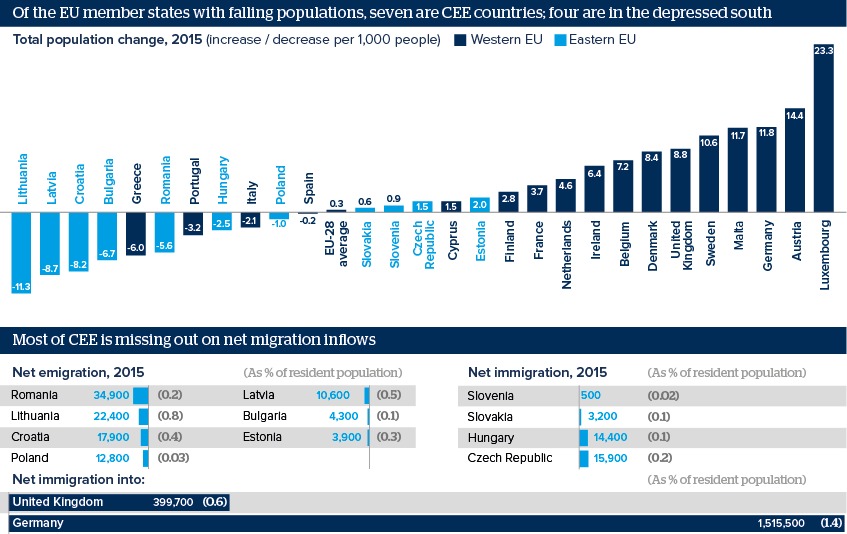Eastern EU has few migrants to bolster population sag
A 'double whammy' of emigration and unfavourable death and birth rates is depopulating eastern EU member states
Source: Eurostat, Oxford Analytica
Outlook
The trend in several Central and Eastern European (CEE) countries for the death rate to exceed the birth rate will abate only slowly. In Bulgaria in 2015, there were 15.3 deaths per 1,000 population, and only 9.2 live births, resulting in a natural fall in the population by an EU record of 6.2 per 1,000. Elsewhere, the death rate is higher than the EU average in Lithuania, Latvia, Hungary, Romania, Croatia, Estonia, Czech Republic and Poland, and the birth rate is lower and falling in Croatia, Romania, Hungary and Poland; the result is natural population decline over much of CEE.
Immigration can be a countervailing factor. However, it is only so in the Czech Republic, Hungary, Slovakia and (barely) Slovenia. Elsewhere in CEE, emigration is reinforcing population decline.
Impacts
- Lithuania will continue to lead the EU in population decline without a substantial reversal of net emigration.
- A pull factor for returnees and foreigners will be economic growth, the likely explanation for positive net migration in the Czech Republic.
- Eastern EU states will need to spend more on health including preventative care to bring down high death rates.
- No CEE state is likely to approach the scale of net migration in Germany, where it forms 1.4% of the resident population.
See also
- Justice system and corruption dog Bulgaria’s euro bid - Jul 12, 2019
- Warsaw hopes as many as 25% of UK Poles may return - Feb 28, 2017
- Older Lithuanian parties may use newcomers’ weaknesses - Jan 12, 2017
- Growth-promoting reforms in Estonia will take time - Nov 10, 2016
- Labour shortages will push up wages in Baltic states - Oct 25, 2016
- Next Lithuanian coalition could be unstable - Oct 10, 2016
- Politics will limit Hungarian labour shortage response - Sep 15, 2016
- Warsaw may fail to entice back many UK-settled Poles - Sep 7, 2016
- Demographics will underpin global productivity trends - Jun 9, 2016
- More graphic analysis
